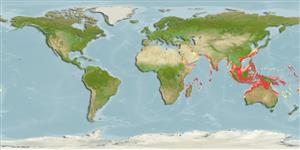Common names from other countries
Environment: milieu / climate zone / depth range / distribution range
Ecología
marino; salobre demersal; anfidromo (Ref. 51243); rango de profundidad 2 - 160 m (Ref. 47581). Tropical; 31°N - 27°S, 36°E - 178°W
Indo-West Pacific: Port Sudan in the Red Sea and the Persian Gulf to Japan, the Arafura Sea (Ref. 9819), and Australia.
Length at first maturity / Tamaño / Peso / Age
Maturity: Lm 9.3 range ? - ? cm
Max length : 14.0 cm TL macho / no sexado; (Ref. 1372); common length : 8.0 cm TL macho / no sexado; (Ref. 3424); peso máximo publicado: 19.00 g (Ref. 126702)
Espinas dorsales (total): 8; Radios blandos dorsales (total): 16-17; Espinas anales 3; Radios blandos anales: 14.
Found over muddy sand bottoms of coastal inshore waters (Ref. 47581). Often enters estuaries (Ref. 4833). Forms schools. Used in Chinese medicine (Ref. 12166).
James, P.S.B.R., 1984. Leiognathidae. In W. Fischer and G. Bianchi (eds.) FAO species identification sheets for fishery purposes. Western Indian Ocean (Fishing Area 51). Vol. 2. FAO, Rome. pag. var. (Ref. 3424)
IUCN Red List Status (Ref. 130435)
CITES (Ref. 128078)
Not Evaluated
Threat to humans
Harmless
Human uses
Pesquerías: escaso valor comercial
Herramientas
Special reports
Download XML
Fuentes de Internet
Estimates based on models
Preferred temperature (Ref.
115969): 24.5 - 29, mean 28 (based on 2086 cells).
Phylogenetic diversity index (Ref.
82804): PD
50 = 0.5625 [Uniqueness, from 0.5 = low to 2.0 = high].
Bayesian length-weight: a=0.01995 (0.01577 - 0.02524), b=2.92 (2.86 - 2.98), in cm Total Length, based on LWR estimates for this species (Ref.
93245).
Nivel trófico (Ref.
69278): 2.9 ±0.3 se; based on diet studies.
Resiliencia (Ref.
120179): Alto, población duplicada en un tiempo mínimo inferior a 15 meses (K=0.88-2.63; tm=1.2).
Fishing Vulnerability (Ref.
59153): Low vulnerability (14 of 100).
